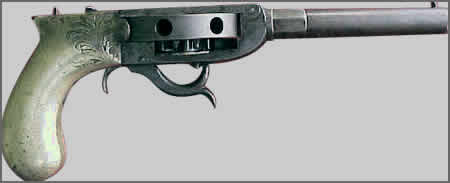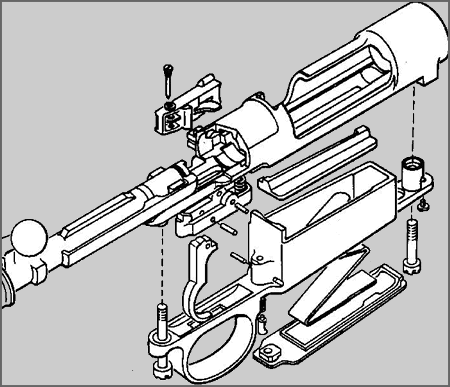Home | Glossary | Resources | Help | Contact Us | Course Map
Archival Notice
This is an archive page that is no longer being updated. It may contain outdated information and links may no longer function as originally intended.
Repeating Firearms
A repeating firearm carries a supply of ammunition and provides a mechanical means to move the cartridges in and out of a single chamber. The goal is to achieve high firing rates while eliminating user handling of ammunition between shots.
Multishot wheel lock and flintlock firearms are examples of the earliest designs that called for loading one charge (powder and ball) atop another until several shots occupied the barrel. Multiple ignition devices (locks) lined up or a single moving lock would discharge the loads. The downfall of this system was that the front charge could accidentally ignite one or more of the others.
Later, multibarrel arms offered more shots in rapid succession, but the increased bulk and weight of more than two barrels was unacceptable. Attempts at multiple moving chamber blocks (each separately charged) was a good start but far too complex for the ignition systems and propellants of the time.
The first effective repeaters appeared in the percussion era. Percussion cap ignition reduced the bulk of the firing system, leaving room for a repeating mechanism that could move between a single barrel and the firing mechanism. Some looked like harmonicas, with a rectangular block bearing the chambers moving through a central frame. Each moved in turn behind the barrel for firing.
Others, like the Cochran revolver, had flat cylinders with chambers arranged around the circumference, resulting in a very bulky firearm that was too impractical to carry.
Handguns
A pattern still seen today in the modern revolver was the cylindrical chamber with the charge holes parallel to the long axis of the cylinder. Compact and reliable percussion ignition allowed manufacturers (like Colt, Adams, and Tranter) to concentrate on the task of indexing the cylinder behind the barrel.
The key to revolver success is the lockwork that controls the timing and position of the cylinder. If a chamber is not aligned with the barrel at the time of discharge, shavings of lead can spew out with the potential for injury. Misalignment lessens accuracy. If good design and construction overcome these timing issues, the revolver is an effective repeater, in either percussion or cartridge version. Both rifles and handguns were manufactured using the revolving cylinder principle.
Colts design, separating the function of the cylinder lock bolt from the trigger, proved to be the most successful. In lesser designs, the cylinder lock bolt was part of the trigger and did not engage until the trigger was pulled; cylinder misalignment could occur when the chamber fired.
In the Colt, the hammer activated a lever-based locking bolt in the following sequence:
- When the user began the cocking motion of the hammer, the bolt dropped out of the way, allowing the cylinder to rotate.
- Before the hammer was fully cocked, the spring-loaded latch released from the hammer and bore against the turning cylinder.
- When the next latch hole in the cylinder rolled around, the latch sprung into it, securing the cylinder in firing position.
- The cylinder was locked before the trigger was pulled and alignment was achieved and maintained.
This advantage made Colt the leader in single-action revolvers for decades. It was not until the mid-twentieth century that significant design and safety upgrades improved some of Colts original concepts.
The basic Colt design epitomized the single-action revolver. Although simple and robust, the requirement of manual cocking between shots slowed the rate of fire. Smith & Wesson perfected the double-action revolver for increased rate of fire. When the location of the cylinder-rotating mechanism was changed from the hammer to the trigger, pulling the trigger both cocked and fired the revolver.
In spite of the increased rate of fire afforded by double-action design, it was not until the latter part of the twentieth century that double-action revolvers were chambered for more powerful cartridges. The simple single-action design proved more reliable and less prone to wear when firing the more powerful revolver cartridges.
Shoulder Arms
Cartridge firearms with long bolts, could be easily converted into repeaters. The original Mauser Model 1871 bolt-action service rifle was a single-shot firearm. In 1884, the basic design was modified, adding a long, tubular magazine under the barrel. A magazine spring put rearward pressure on the cartridges and a tilting tray under the bolt picked up a cartridge when the bolt handle was pulled to the rear. The resulting Mauser Model 71/84 repeater looked nearly identical externally to the older Model 1871; the extra parts required for repeating fit within the original pattern.
With fixed cartridges available, Oliver Winchester bought the rights to the Volcanic lever-action repeater from the firm of Robbins & Lawrence. The Volcanic was an early cartridge repeater that used caseless cartridges. The Henry repeating rifle saw limited service during the Civil War. In 1860, Henry made improvements to facilitate magazine loading. In 1866, the Henry design was further refined and sold by the new Winchester Repeating Arms Company. as the famous Winchester Model 1866. This was the first in a long and respected line of lever-action repeating rifles for Winchester.
These early Winchester repeaters linked the lever that moved the bolt to a lifter block just behind the magazine. When the lever was operated, the top of the block knocked the fired case from the chamber. A recess in the middle of the block held a cartridge that had been pushed there by the magazine spring. As the block continued to rise, the new cartridge was held in alignment with the chamber and the bolt could then push it forward.
A single lever cycle in the Winchester rifle accomplished the following:
- Extracted a fired case from the chamber
- Cocked the hammer
- Ejected the fired case out of the rifle
- Positioned the new cartridge
- Chambered the next cartridge
- Fed another round into the lifter block
Slide (Pump) Action
Some makers, including Colt and Remington, developed rifles that abandoned the lever and turn-bolt action concepts for a design that was more ergonomic when fast repeated shots were required. These slide-action rifles and shotguns had internal parts similar to a lever action, but these parts were connected to the forearm of the firearm where the shooters support hand rests. The forearm was moveable, not fixed as in previous shoulder-fired arms. A quick rearward movement of the supporting hand unlocked and opened the action for ejection and reloading.
Box Magazine
Tubular magazines hold a large number of cartridges tip-to-base under the barrel. Traditionally, they could not handle ammunition loaded with sharply pointed bullets. Recoil from one cartridge firing could jar the ammunition in the magazine; a pointed bullet with a metal tip could act as a firing pin. With enough recoil, a cartridge could discharge in the magazine. In 2006, over 150 years after the introduction of fixed cartridges, pointed, soft polymer tips were introduced for tubular magazines and appear to have solved this problem.
The box magazine was a simple solution:
- Cartridges are stacked vertically and may be staggered side-to-side to save room.
- A classic box magazine is positioned so that its rear surface is a fraction of an inch forward of the bolt face when the action is fully open.
- Cartridges get constant upward pressure from a spring in the bottom of the magazine.
- When the action is closed, the bolt body holds the cartridges in the magazine.
- When the bolt is fully open and retracted, the magazine spring pushes the top cartridge against raised lips around the top of the magazine. These lips are positioned so that the top cartridge is slightly raised allowing the bolt face to engage and push it forward, out of the magazine and into the chamber.
A key advantage to the box magazine is that ammunition in stripper clips can be quickly loaded into the magazine. Typically, five cartridges can be loaded with a single motion.
Additional Online Courses
- What Every First Responding Officer Should Know About DNA Evidence
- Collecting DNA Evidence at Property Crime Scenes
- DNA – A Prosecutor’s Practice Notebook
- Crime Scene and DNA Basics
- Laboratory Safety Programs
- DNA Amplification
- Population Genetics and Statistics
- Non-STR DNA Markers: SNPs, Y-STRs, LCN and mtDNA
- Firearms Examiner Training
- Forensic DNA Education for Law Enforcement Decisionmakers
- What Every Investigator and Evidence Technician Should Know About DNA Evidence
- Principles of Forensic DNA for Officers of the Court
- Law 101: Legal Guide for the Forensic Expert
- Laboratory Orientation and Testing of Body Fluids and Tissues
- DNA Extraction and Quantitation
- STR Data Analysis and Interpretation
- Communication Skills, Report Writing, and Courtroom Testimony
- Español for Law Enforcement
- Amplified DNA Product Separation for Forensic Analysts





